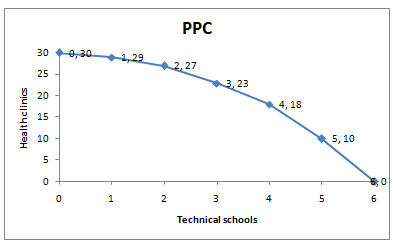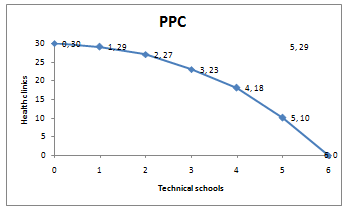Question:
Scenario:
You have been hired as the economics adviser for the newly elected State Premier. On your first day, the Premier introduces you to the new Minister for Health and the Minister for Education and Training, and explains that your expertise is needed to settle a policy debate. The Minister for Education and Training wants to build 6 new technical schools to train new trades people to help solve the critical shortage of skilled workers. The Minister for Health wants to establish 30 health clinics that provide specialised childhood, preventative and early intervention medical services to improve public health in disadvantaged communities. The Premier asks you if this is possible. You are unsure, and question whether the economy has the resources to do both. The Minister for Education and Training says he won't accept less than 5 new technical schools. The Minister for Health says she will agree to no less than 29 new clinics. The Premier says that this compromise of 5 facilities and 29 clinics seems fair. You then calmly suggest that before a policy is announced, it might be worthwhile working out what is actually possible. Before the Cabinet Meeting at 10.00 am tomorrow morning, you have to write a report that answers the following
Questions:
(a) Why might you suspect (even without evidence) that the economy might not be able to produce all the schools and clinics the Ministers want? What constraints are there on an economy's production?
(b) The Premier provides you with the following production possibilities data recording combinations of schools and clinics produced over past years.
Technical Schools Health Clinics
0 30
1 29
2 27
3 23
4 18
5 10
6 0
Given this information, draw a production possibilities curve (PPC) for the economy, labelling the axes and each combination. Explain why the line is curved and not straight, with reference to the concept of opportunity cost. Were you right to suspect the economy could not produce 6 schools and 30 clinics at once? Explain why.
(c) Explain the concepts of efficiency and inefficiency in relation to the PPC. Consider the Minister for Education and Training and the Minister for Health's second choices of 5 schools and 29 clinics and mark it on your graph. Is this combination possible or efficient? Explain.
(d) The Premier wants to improve all possible and efficient outcomes, to keep the people happy with the government. He understands that this year's production is restricted, but next year he wants to provide both 6 schools and 30 clinics. Describe two different changes in the economy that could make this possible.
(e) Explain in just a few lines, if it were up to you, which combination of technical schools and health clinics you would choose to produce, and why. In terms of kinds of economic analysis, what makes your answer for (e) different to those for questions (a) to (d)? Are other economists likely to agree with your analysis in parts (a) to (d)? Are they likely to agree with your preferred choice in (e)? Explain.
Answer:
- The economy might not be able to produce 29 health clinics and 5 technical schools because there might not be enough resources in the economy to produce them. It may be possible that either 29 clinics or 5 schools might be built, but both not together. The 29 clinics and 5 schools combination may not lie on the production possibility frontier.
The constraints on production are the availability of labor and raw materials required to build these buildings, which will translate into either unavailability of physical labor and raw material or the monetary requirement for it or both.

The line is curved because the opportunity cost of producing technical schools increases as the number of technical schools increases. This can be seen by the fact that first unit of technical schools takes resources to produce only one unit of health clinics, while it increases to 2,4,5,8 and 10 respectively for next 5 units.
Yes, the expectation was right as the economy cannot produce the combination of 6 schools and 30 clinics.
- In terms of PPC, efficiency means that the desired combination of the goods lies on the curve and not inside the curve. A bundle inside the curve, on the other hand, is inefficient as more of either or one of the goods could be produced with the same amount of resources.

This combination is not possible. This is because of the fact that this bundle does not lie on or below the PPC- it lies above it. Any bundle above the PPC is not achievable for the economy, at least in the short run.
- Two main sources through which the production of 30 clinics and 6 schools is possible next year are (i) technological advancement so that the efficiency of production is increased and/or (ii) utilization of untapped resources. Technological advancement like new machines for construction can increase the efficiency of labor while tapping the unutilized resources will increase the amount of raw materials available, thereby expanding the production possibilities.
- I would prefer the combination with 5 technical schools and 10 health clinics. The reason for this is that I would like the talent pool of the economy to broaden, which will eventually bring about technological change through research and development. Also, a talent labor pool will increase the productivity. Regarding health clinics, 10 health clinics may suffice if the staffing is adjusted accordingly and the government provides the deprived people with conveyance to travel to the health clinics in case they live far off from the clinic.
This solution is based on subjective decision making, where the possibility of finding efficient combinations is not an issue. Here, the issue is to determine which combination to use based on the criteria in the mind of the decision maker.
Most of the economists will agree to the answers in the above parts as there is nothing one can do about availability of resources in the short run.
As I mentioned above, the decision making here is subjective. Therefore, while some people might want better health facilities for deprived people, other people might want a better talent pool so that production possibilities can be expanded and eventually, we may develop enough production capacity that the problems of deprived people can be completely eradicated.